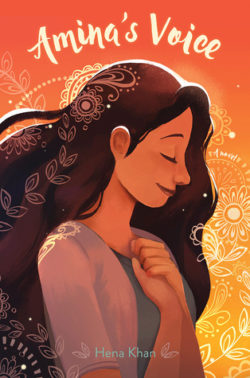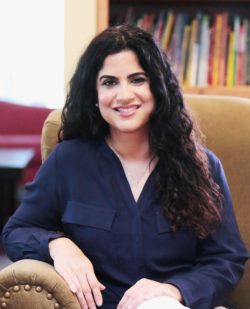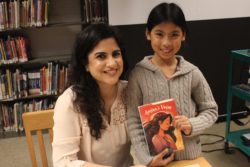
“It Gives Me a Tremendous Amount of Hope:” Author Hena Khan on Kids, Tolerance, and the Universal Experience of Middle School
 Middle school anxiety does not discriminate, Amina’s Voice author Hena Khan told First Book. It’s why we all can mirror each other’s experiences in some way, no matter where we’re from—and that gives Khan hope, she said. Read more about Hena, Amina, and the relatability of generous aunties in our conversation with her below:
Middle school anxiety does not discriminate, Amina’s Voice author Hena Khan told First Book. It’s why we all can mirror each other’s experiences in some way, no matter where we’re from—and that gives Khan hope, she said. Read more about Hena, Amina, and the relatability of generous aunties in our conversation with her below:
Find Amina’s Voice on the First Book Marketplace
***
First Book: Your middle grade novel Amina’s Voice is about a girl who, like you, is a Pakistani-American Muslim. How much did your own background and personal experiences shape this story?

Hena Khan: Quite a bit! Several of the major themes in the book came from my own experience, like Amina’s friendship with Soojin, a Korean-American girl who is thinking of changing her name; her uncle who comes to visit from Pakistan; and I’m afraid to admit, the memory of a boy in kindergarten asking her why she had grass growing on her legs. A lot of Amina’s feelings—her shyness, worrying, and wanting to please her parents—come from my own personality. But the character is definitely fictional, especially the parts related to her singing ability (just ask my kids!). It’s also important to note that Amina’s family is representative of just one Muslim family in America, and that tremendous variety exists even among Pakistani-Americans, let alone the other 90 percent of American Muslims who have both been in the U.S. for many generations, or immigrated from almost 80 different countries around the globe. When thinking of her family and creating her community, I blended those I have witnessed and gotten to know in my life.
FB: Much of Amina’s story depicts typical experiences of or interactions between all kids in middle school. How do you balance your desire for universality and relatability for all readers with your desire to include culturally specific details that can act as mirrors for readers of your own faith and/or culture?
HK: My ultimate goal is to create layered and multidimensional characters that all types of people can relate to—male or female, young or old, from any ethnic and religious background. We’ve all felt Amina’s anxieties, jealousy, inhibitions, and fears in one form or another, especially during those very special middle school years! The details I include about my specific culture help shape Amina as a person, but they are just one part of Amina’s reality, like Ramona Quimby’s neighborhood or the prairie life Laura Ingalls Wilder lived. The fact that those characters’ daily lives didn’t mirror mine didn’t make them any less relatable to me on many levels, as a Pakistani-American child of immigrants growing up in the 1980s and balancing two cultures.
At the same time, of course it makes me happy to hear that people from similar backgrounds see pieces of their lives reflected in Amina’s. It’s important to me for readers to have that opportunity, especially since I didn’t have the chance to see myself, or a family like mine, in a book when I was growing up. It makes me smile when someone from a completely different immigrant community says that could connect, or that they too have an auntie who sends home leftover food in an empty yogurt container!
I strongly believe representation matters. But I hope that my book isn’t viewed as a mirror OR a window, and that it can serve as both to ALL types of readers at the same time. I’ve been happy to hear that a white Christian boy living in upstate New York said he could relate to Amina, alongside a recent Somali refugee girl living in Atlanta whose ESL instructor said it was the first book in English she was motivated to finish. I suspect they both found things that reflected their own experience, and served as a window to something new, in completely different ways.
I’ve been happy to hear that a white Christian boy living in upstate New York said he could relate to Amina, alongside a recent Somali refugee girl living in Atlanta…
FB: Amina’s family is directly impacted by intolerance within their own community. What do you hope readers will take away from this aspect of her story?
HK: I included the incident of mosque vandalism while I was writing the book over five years ago, at a time when it wasn’t occurring with the same frequency we’ve been seeing more recently. Even then, I knew it was a tragic reality for different faith communities, not just Muslims. I hope that readers who aren’t familiar with an Islamic center or a mosque get to know a community of Muslims, and perhaps even recognize the things that are common to most faith-based community institutions: pizza lunches, praying in congregation, book sales and volunteerism, and even kids getting bored during Sunday School. What I hope all readers take away from this part of Amina’s story—which is just a part of her personal journey—is to be able put themselves in her shoes and experience the loss, fear, violation, and pain of a hate motivated attack on a place of worship. I then want them to witness the power of a loving response of a diverse community to stand by their neighbors and friends and overcome hate, and to ultimately feel uplifted and hopeful. I’m heartened to see that a similar response is what has actually been happening around the country when such events occur.
FB: Your forthcoming chapter book series – Zayd Saleem, Chasing the Dream – is about a basketball-obsessed fourth grade boy who aspires to be the first Pakistani-American kid to make it to the NBA. What inspired Zayd’s story and what things can readers look forward to discovering or learning about as they read his adventures?
HK: Zayd’s adventures are largely inspired by my basketball-obsessed husband and by my two sons who have followed in their father’s footsteps. Zayd’s personality is a combination of all three of them in many ways, and his series was a blast to write! Readers can look forward to rooting for a character who’s likeable but flawed, who’s the underdog, and who has to learn to stand up for himself and overcome obstacles in the way of his dreams. He has a family filled with strong personalities, including my favorite character: his grandmother Naano, who likes to gamble and curse in Urdu. I won’t say who she’s inspired by, but let’s just say I can’t wait for my mother to read the first book! Readers will learn unique things about Pakistani culture, like overdramatic television drama, over-the-top weddings, and over-feeding our guests. I borrowed heavily from my family’s lives while writing the series, including the first chapter in “POWER FORWARD,” a funny story that my husband loves to retell from his childhood, over and over again. I hope the story will feel authentic and be as enjoyable to read as it has been to write!
I’m always amazed at the creative things educators do with my books…
FB: We love your picture book Golden Domes and Silver Lanterns: A Muslim Book of Colors, and can’t wait to introduce First Book members to the new companion book, Crescent Moons and Pointed Minarets: A Muslim Book of Shapes coming out in April. Can you suggest some fun ways that educators can (or already do!) use these books in the classroom?
HK: I’m always amazed at the creative things educators do with my books, from the simplest craft to developing the most elaborate lessons plans. For Golden Domes and Silver Lanterns, I’ve seen kids make paper lanterns and other art projects, explore colors in a multitude of ways, share traditions and holidays, work on rhyming text, and more. For Crescent Moons and Pointed Minarets, I’m excited to see some great ideas already percolating before the book has come out! There’s a lot that can be done with shapes, including exploring geometric patterns and math concepts in interactive ways. Plus since the book is set around the world, it’s a great launching point for social studies.
I’m thrilled to have seen educators use the picture books in preschool all the way through middle school as part of their teaching of Islamic culture and traditions from a variety of disciplines. Also, I’m happy to share that Chronicle has created a lovely teacher guide for Crescent Moons, along with Golden Domes, and my first picture book, Night of the Moon, which releases in paperback this spring.
FB: You travel and give presentations to students often. Can you relate what you have learned from interacting with children as a result of your many school visits?

HK: Interacting with kids is the best part of what I do! It helps me in so many ways to hear their thoughts, answer their questions, and even get suggestions on book ideas or sequels. One thing I’ve learned from kids is that they are capable of understanding complex concepts and ideas and, like all people, they appreciate respect and being treated like thinking individuals. I’ve witnessed how curious, open minded, and empathetic they naturally are, and how loving they can be. They are eager to make connections between their lives and mine, and those of my characters. And it’s clear that they value storytelling and let the books they read help shape their worldview. It gives me a tremendous amount of hope to see and spend time with kids.
